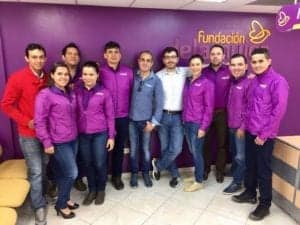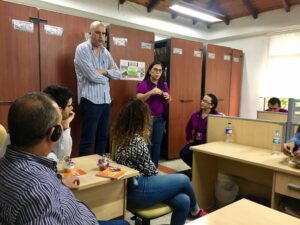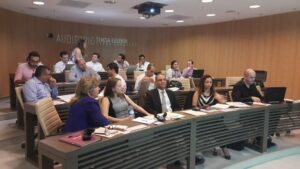What does client-centric innovation actually look like? Last November, I had the privilege of witnessing that myself during a four-day exposure visit to Women’s World Banking Network Member Fundación delamujer in Colombia. I joined senior management from Egyptian Network Member Lead Foundation (Lead), along with our Microinsurance Director, Gilles Renouil.
The visit facilitated the sharing of best practices and lessons learned by Fundación delamujer during the design and implementation of rural credit products and microinsurance to Lead Foundation who recently launched a rural credit pilot.

We learned about Fundación delamujer’s approach to client-centric innovation through two key investments: digitizing operations and knowledge management.
Invest in digitizing operations
Fundación delamujer covers 92% of Colombia, including rural populations dispersed throughout the countryside. Digitizing operations offered a way to reduce turnaround times in processing loan applications while significantly increasing the productivity of its staff.
The institution introduced a mobile application with real-time syncing to its management information system. With this app, Loan Officers in the field can input a potential client’s information and receive immediate feedback on his or her history with the institution, credit score information, and any outstanding debts. Beyond speeding up the eligibility screening of applicants, the app helps officers avoid raising expectations of potential clients or wasting valuable time that could be spent working on an income-generating activity.

The application was piloted over a four-month period with a top-down change management approach: first rolled out to regional directors then cascaded all the way down to branch staff. The process has been very successful: the total time for a Loan Officer to adapt to the technology is just 15 days. Lastly, the application allows the institution to maintain a complete record of all Loan Officer interactions with a client, which is key in ensuring consistent customer service.
The timing of seeing Fundacion delamujer’s digitization effort was incredibly opportune for Lead Foundation. The institution is in the middle of building out its operations and there is room to make integrating the best practice they witnessed a priority.
Lead’s Training & Research Manager George Shihata noted the value of this investment: “integrating digitalization into the financial assessment and loan approval process is a main advantage [for] the institution,” one that improves the client and staff experience by eliminating potential inefficiencies from the screening process for both staff and potential clients
Invest in knowledge management
Rural businesses are very different from enterprises in the urban market. Thus, a critical component of lending to the rural segment is a strong understanding of the way rural businesses work. Fundación delamujer’s analysis of the competition revealed that others in the market were largely taking an urban credit product and introducing it to the rural sector without any changes. The result? A large part of the rural population remained un- or under-served.
With an eye toward properly serving the unmet needs of the segment, Fundación delamujer focused on ensuring its Loan Officers have the information they need to conduct a proper financial analysis of rural activities via training and additional learning tools.

Initial training focuses on specific regional activities and the way those activities function in each region (i.e., how growing coffee may be different in the region of Santander versus Antioquia). A continuing education component of the training is led at the branch level, whereby branch staff put together technical sheets on rural activities: examples of cycles, costs of production, and general sales figures based on a study of ten to fifteen clients. These sheets are uploaded to an intranet and made available to all branch staff, creating a living library of knowledge about rural lending activities. This library allows its staff to be the experts and truly understand the way the institution’s clients run their businesses.
As Lead Foundation continues its pilot of a rural lending product through early 2018, the team is excited about putting together a similar library to build the expertise of its own staff in a new market. The learning tool will help Loan Officers better understand the activities of their clients and conduct financial assessments more effectively.
The importance of evaluation and pivoting during the introduction of new tools or processes came up time and time again during the visit. Each of the above investments were not one-time efforts to revamp an operational aspect at Fundación delamujer. They are part of an evolutionary process to innovation, where the institution pilots, assesses, and makes changes as needed.
In digitizing operations, the institution piloted training materials and continually updates them based on gaps in knowledge and participant feedback.
With knowledge management, Fundación delamujer understood that those most engaged with rural activities are those who best understand them. Fundación delamujer makes it a point to understand how its clients are running their businesses, what factors (input prices, sales prices, etc.) influence their activities’ outcomes and assesses this regularly to understand how this might change over time.
The critical component in each of the innovations made by the institution is the focus on client-centric innovation. A lot can be done to increase financial inclusion for women not only by focusing on product design, but also by continuous understanding women’s productive activities and streamlining operations to reach them.
About the institutions
Fundación delamujer is one of three Women’s World Banking Network Member institutions that participated in the “Development of Rural Credit Products with a Gender-Lens” project launched in 2012. The project aimed to create access to credit products for rural populations and make visible the economic contribution of rural women to their households. Through the end of the project, more than 60,000 loans were disbursed at an average of USD 1,000, including 30,000 loans to new clients. The project was financed by the IDB, Irish Aid, Hivos, and Credit Suisse and concluded at the end of 2014.
As part of its product offerings, Fundación delamujer also offers voluntary microinsurance products that cover more than 90% of the institutions 350,000+ clients.
Lead Foundation is a non-governmental organization based in Egypt that focuses on giving every client the opportunity to move forward by partnering with each client, bringing a professional approach to understanding the client’s business and offering adequate microfinance services with transparent and simple communication.
It serves more than 193,000 clients. With support from MetLife Foundation, Women’s World Banking has worked with Lead Foundation to strengthen and expand its individual lending products, including a rural expansion launched in July 2017. With support from Swiss Capacity Building Facility and Visa, Inc., Women’s World Banking also collaborates with Lead Foundation in the development and expansion of a microinsurance p




